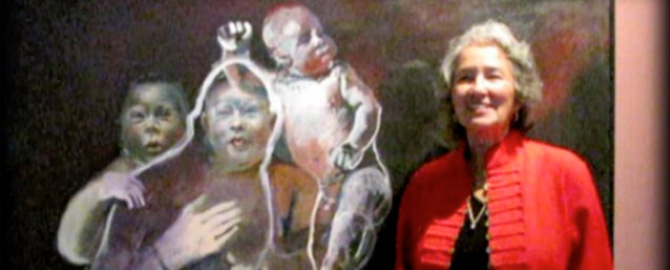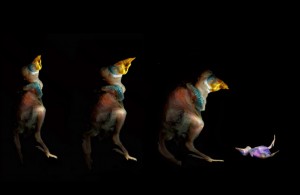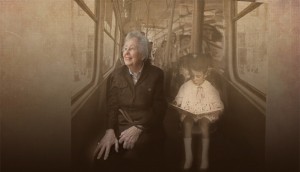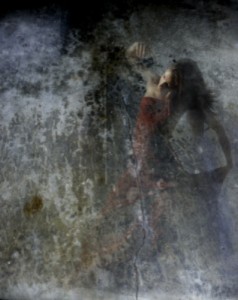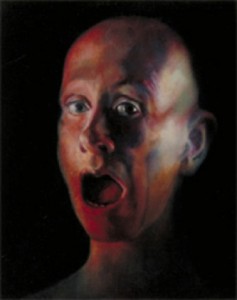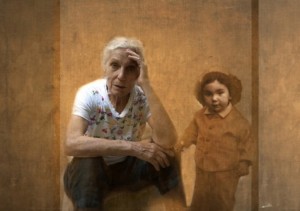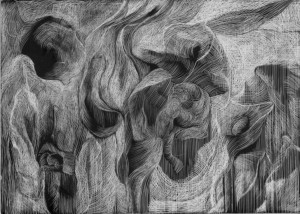 Kathryn Jacobi’s an artist excelling in a multitude of disciplines. Describing herself as a painter, printmaker, photographer and a digital artist she has had a long and sucessful career of over 3 and a half decades – she has, a whole host of accolades.
Kathryn Jacobi’s an artist excelling in a multitude of disciplines. Describing herself as a painter, printmaker, photographer and a digital artist she has had a long and sucessful career of over 3 and a half decades – she has, a whole host of accolades.
Jacobi’s work is classical in its approach to its style, colour and tonal choice. It has frequent atmospherical and disturbing references to historical works, including Millais’ Ophelia. Despite the classical orientation, the themes fervently explore hauntingly eerie compositions and dreamlike states that wouldn’t appear out of place in Cirque du Soleil’s Saltimbanco.
Despite categorising her paintings into two, representational paintings and imagined, there is still a strong visual relationship between the two. Jacobi composes abnormally odd arrangements that explore both positive and negative space. She determines the autonomous voids in her work by suspending them in a state of awkwardness, intentionally abstracting the subject and theme undertaken. This is particularly evident in her series of works, Operatic Duets.
In her own words
Could you please introduce yourself and tell us a bit about your background and how you choose Painting over any other discipline.
I am is a classically trained, contemporary realist painter, printmaker, and photographer who has been working professionally for over 40 years, exhibiting in galleries and museums throughout the United States, Canada, and Europe. Over my life as an artist, I have always worked on two consecutive bodies of paintings that are distinct and separate from each other. The first group is from direct observation or based on old photographs and relates to my experience of the world. The second group derives from my imagination, the paintings collectively weaving a narrative of my inner life and its journeys. Over the past decade, I have also become more and more intrigued with the creative possibilities for making images inherent in digital photography and the computer darkroom, and now consider this a third avenue of practice and exploration.
I was born in Manhattan in 1947 and attended UCLA, UCBerkeley, and California State University Northridge where I received my BA in 1978 and my MA in 1980. While I have spent much of my life in California (I presently live in Santa Monica and has a studio in Los Angeles) where I have spent much of the past 2 decades in the forests of British Columbia where I had a second home and studios.
Your imagined pieces are dark in both terms of colour, tone and subject. Why is this? How do these pieces manifest and grow?
The body of my imagined work comes from the inside out. It bypasses rational observation, being instead an imagined response to the world as I find it. These paintings reflect both “waking dreams,” which are hypnogogic states that occur in that midway moment between sleep and waking, and dreams themselves. The associative process underlying my imagined work has much in common with the one underlying stream-of-consciousness writing. One image suggests the next, not in a linear progression, but instead through nuance, movement, and attention to the entire surface of the painting. The resulting images are surprising, especially to me, and fluctuate from the mysterious and frightening to the funny and engaging. Individually, they originate as uncensored explorations, but in groups they form patterns of meaning that coalesce into a dominant metaphor. I believe this metaphoric coalescence to be the essential underpinning of all imagined narratives, and certainly it has that function in my own work. Each painting within a group becomes a variant that infuses relevant (if illusive) information into the whole.
What are you most proud of and why?
I tend to be most proud of the work that has stretched my limits the farthest. I always am challenged, after all these years and hundreds, possibly thousands, of portraits painted, by their innate difficulty. I try to bring each subject to life with a combination of rigor, accuracy, and humility in trying to capture each subject’s essential qualities in my work. Portraits never get easier, despite my increasing confidence in my skills. It is the intangible, the unknowable aspects that make them a constant and enduring part of my studio practice. Every week I devote at least one day to portrait painting, and my most successful portraits may be the work, which makes me most proud.
That said, in every new body of work I embark on, I try to push the limits of my own skills and reach deeper into my emotional reserves, and when work is successful in any genre it makes me proud.
Has there been a shift or change in your life or work that has led to what you’re making now? Do you see your work as autobiographical at all?
The major shift in my life has been the ageing process itself, which has changed and humbled me. Yes, my work is autobiographical in that it has always been a reflection of my concerns at any given time, has been united by the themes of memory, of time and the life-cycle, and of the vagaries of fate. My images, which explore the human condition in the context of our moment in time, vary along with my interpretations: the latter vary as I strive to “cast a cold eye” on our poignant native frailty and vulnerability. As a woman of 66, I find myself engaged with children again, my grandchildren this time around, and it has been yet another of the great shifts of consciousness which is informing my work now.
What are your biggest challenges to creating art and how do you deal with them?
My biggest challenges now, and always, stem from not enough time. Even if I were able to work 20 hours a day, I still would not have the time I need in this lifetime to explore all the avenues which interest me in art, let alone in my daily life. I deal with these challenges by simply being as disciplined as possible in being present in the studio, putting in the hours and being aware of what is important and what is frivolous.
Obviously the figure has been a huge muse for many artists throughout the history or art. What artists or professionals have been your biggest influences?
I have many many influences and heroes, both contemporary and throughout the history of art. I am always discovering artists who impress me enormously. Among the contemporary great painters of the human figure, I would give credit to Vincent Desiderio and Lucien Freud, and Tim Lowly, though there are so many I admire and respect. Historically, I’m drawn to the Spanish masters as well as Rebrandt, Gericault, Kathe Kollwitz— the list is endless!
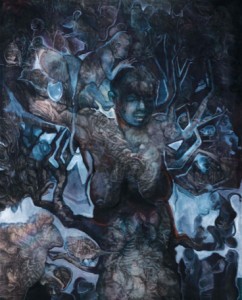 What would you like to be doing with your art ten years from now?
What would you like to be doing with your art ten years from now?
Ten years from now I hope to be doing more of what I am doing now, pushing the limits of my abilities, working hard, and understanding more.
Born 1947, New York, NY, Kathryn Jacobi received her B.A. in 1978 and her M.A. in 1980 from California State University, Northridge. Jacobi has been honored with several awards including many from the National Watercolor Society as well as being part of the Fresno Art Museum’s Council of 100 Distinguished Women Artists for 2010. Jacobi lives in both Santa Monica, California and Sechelt, BC. Her work has been frequently and widely exhibited in museums, universities, and galleries in and around Europe, Canada and the U.S.
All images courtesy of Kathryn Jacobi | www.kathrynjacobi.com
For more information on Hong Kong Art Tutoring please contact:
Gail Deayton
Telephone: +852 9722 8353
Email: gail@hkarttutoring.com
Kathryn Jacobi @ Fresno Art Museum – September 10, 2010 from Hart Art – Brad Polzin on Vimeo.

